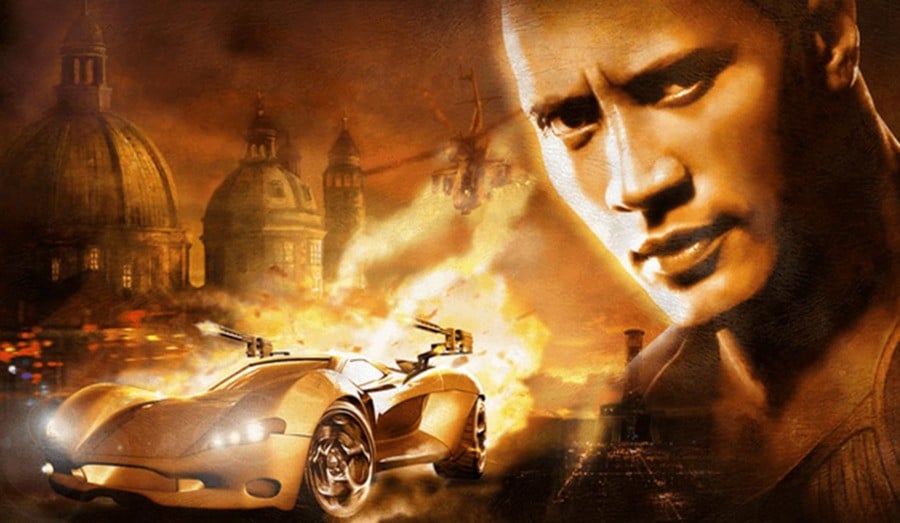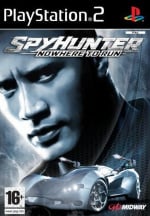
Before he punched torpedoes in Fast and Furious movies, Dwayne “The Rock” Johnson was set to star in a movie adaptation of Midway’s then-recently rebooted Spy Hunter game series. As was the norm in the mid-2000s, a game adaptation of the movie (based on a game) was also planned. The latter went forward. The movie didn’t.
“In the beginning, we were supposed to go along with the movie," recalls Adam Norton, lead artist on Terminal Reality's 2006 SpyHunter movie tie-in game, which launched on PS2, Xbox and PC. "The movie just kept getting pushed and pushed and pushed. We were finally like, well, we have to make the game without the movie."
The original arcade Spy Hunter debuted in 1983, letting players drive a transforming, machine-gunning supercar (with more than a little touch of James Bond) from an overhead perspective. 1987 brought the odd multiplayer-focused Spy Hunter II, and 1991 Sunsoft’s unofficial Nintendo NES sequel Super Spy Hunter (a translation of Japan’s Battle Formula), leaving the series dormant (other than home ports) until a flashy 2001 reboot.
Development studio Terminal Reality, working with publisher Midway, didn’t begin with Midway’s 2001 Spy Hunter game as a base. It started from scratch, because the 2006 Spy Hunter (subtitled Nowhere to Run) was going to require on-foot levels. This necessitated Terminal Reality’s Infernal Engine, developed on a prior project named RoadKill (another part of the studio worked on the unreleased Demonik, which was featured in the movie Grandma’s Boy).
It begs the question of how the team developed anything without an actual movie to bounce off. Turns out, they just guessed. “We didn't get anything from the movie at all," says Norton. "We kept being told that they had a script. And then we were told that they didn't like the script. And they got a new writer, and he was going to do the script now. And so months and months and months went by. The only thing we knew about it was that they wanted to make a movie and have The Rock in it." Level scripter Ryan Darcey, who came onto the project fresh from college, walked into what he describes as chaos. “It was kind of like a perennial inability to keep up with what was going on with the film.”
To move forward, the team focused on technology first, delaying the rest until that wasn’t a possibility anymore. Then came the game systems. “The combat, the driving, and the vehicle transforming; there's a lot of work you can do on that," explains Norton. "They're not really specific to anything. We kind of held off as long as we could on exact locations. Then we finally reached that point where we realized, you know, the game's got to come out, and the movie won’t."
The movie studio didn’t have input, and for publisher Midway, Norton believes it saw this purely as a brand extension worth exploring, movie or not. “Whether there's a movie attached to it or not, Spy Hunter is still one of [Midway’s] franchises. I think they felt like it would be a big hit for them. They just decided they're gonna make this game anyway, whether there's a movie or not.”
SpyHunter: Nowhere To Run required motion capture with Johnson. “They tell you a lot of times you don't want to meet athletes or celebrities that you like, because you'll be disappointed. But he’s exactly like what you see. Like, he's just the coolest dude ever,” said Norton. Darcey remembered the team wanting it to work because of Johnson. “The Rock was awesome. Every interaction that anyone on the team had with him, they just looked on glowingly. We just really wanted to make it work.”
Because of those motion capture sessions, SpyHunter: Nowhere to Run changed form. “Before that, it was more of a shooter,” begins Norton. “Once we realized he was coming in, we put a lot more wrestling-type moves in the game.” Johnson spent his time tossing around a dummy, body slamming and punching it, perfect for a man still heavily involved in pro wrestling.
As Norton remembers it, those weren’t the only issues that led to a lacklustre critical response (the game's Metacritic rating currently stands at 51%). Designers, producers, and marketing struggled to find a middle ground everyone agreed on. “We were trying to make a game where this guy's driving a car that can transform a boat into a motorcycle, which is pretty sci-fi tech,” says Darcey. “And then, within the marketing, people from Midway would come back and say, 'you know, this game is too sci-fi, people don't like that.' We were like, well, that's weird, because this is a car that transforms into a boat instantly.”
Extensions due to the movie’s delays led to a two-year development, which Norton notes was longer than the usual year-to-18 months for that period. Quarterly reviews at Midway meant the team took the time to scrape together makeshift levels to satisfy quotas, but rarely did those elements reach the final game. “It led to smoke and mirrors. It wouldn't actually work in a shipped game,” laments Norton. That made the final stretch a strenuous one. “I would say we were crunching the whole last year.”
SpyHunter's legacy is an odd one, then: a film tie-in that lacks a film to sell, yet still has the lead star involved. "The Rock" has, of course, gone on to become one of Hollywood's most bankable stars and even found time to joke about the negative reaction SpyHunter received at launch. At the 2017 Game Awards, he referenced a particularly scathing review by Game Informer during a skit to promote the Jumanji video game, claiming he was "still pissed" at the 3/10 score – a comment almost certainly made in jest, but one that reveals that Johnson may have some lingering disappointment that SpyHunter didn't turn out better.
But then again, how could it have? An orphaned project was always going to struggle to come together as a cohesive whole. “It was just a lot of excitement that this could be something special, if it actually comes together, if all the pieces align," concludes Darcey. "But it just never seemed like it was. It was really hard to find that synergy with the film."

